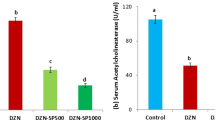Abstract
Cyanide, known as a potent suicidal, homicidal and chemical warfare agent, is widely found in plants and used in industry. Cytochrome oxidase, the main enzyme in cell respiration, is inhibited by cyanide resulting to acute or chronic toxicity. The effects of garlic (Allium sativum) and its chief compound, allicin, on the acute lethality of cyanide were studied in rats. Three groups of rats were fed a diet containing 10%, 20% and 30% garlic powder for 48 h and then were challenged with 10 mg/kg cyanide. The lethality of cyanide intoxication was markedly reduced in rats which received garlic by diet and the rate of protection was dose-dependent. The effect of 1,000 ppm of allicin on cyanide lethality was equal to 20% of garlic in diet. These results suggest that sulfur compounds of garlic may have a protective effect against cyanide intoxication.
Similar content being viewed by others
References
Aslani MR, Mohri M, Maleki M, Sharifi K, Mohammadi GR, Chamsaz M (2004) Mass cyanide intoxication in sheep. Vet Hum Toxicol 46:186–187
Baskin SI, Reagor JC (1997) Cyanide poisoning. In: Sidell FR, Takafuji T, Franz DR (eds) Medical aspects of chemical and biological warfare, Office of the Surgeon General, Washington
Baskin SI, Horowitz AM, Nealley EW (1992) The antidotal action of sodium nitrite and sodium thiosulfate against cyanide poisoning. J Clin Pharmacol 32:368–375
Baskin SI, Porter DW, Rockwood GA, Romano JA, Patel HC, Kiser RC, Cook CM, Ternay AL (1999) In vitro and in vivo comparison of sulfur donors as antidotes to acute cyanide intoxication. J Appl Toxicol 19:173–183
Bhattacharya R (2000) Antidotes to cyanide poisoning: Present status. Ind J Pharmacol 32:44–101
Block H (1996) The chemistry of garlic and onions. Sci Am 252:114–119
Mathangi DC, Namasivayam A (2000) Effect of chronic cyanide intoxication on memory in albino rats. Food Chem Toxicol 38:51–55
Megarbane B (2003) Antidotal treatment of cyanide poisoning. J Chin Med Ass 66:193–203
Nagahara N, Nishino T (1996) Role of amino acid residues in the active site of rat liver mercaptopyruvate sulfurtransferase. J Biol Chem 271:27395–27401
Nagahara N, Li Q, Sawada N (2003) Do antidotes for acute cyanide poisoning act on mercaptopyruvate sulfurtransferase to facilitate detoxification? Curr Drug Targets Immune Endocr Metabol Disord 3:198–204
Newall CA, Anderson LA, Phillipson JD (1996) Herbal medicines: a guide for health-care professionals. Pharmaceutical Press, London, p 296
Okolie NP, Osagie AU (2000) Differential effects of chronic cyanide intoxication on heart, lung and pancreatic tissues. Food and Chem Toxicol 38:543–548
Radostits OM, Gay CG, Blood DC, Hinchcliff KW (2000) Veterinary medicine, 9th edn. Saunders Company, London
Soto-Blanco B, Maiorka PC, Gorniak SL (2002) Neuropathologic study of long term cyanide administration in goats. Food Chem Toxicol 40:1693–1698
Tewe OO, Iyayi EA (1989) Cyanide glycosides. In: Cheek PR (ed) Toxicants of plant origin, vol II. CRC Press, Florida, pp 43–60
Acknowledgement
We wish to thank Dr. P. Josling from Nopex-UK for supplying allicin.
Author information
Authors and Affiliations
Corresponding author
Rights and permissions
About this article
Cite this article
Aslani, M.R., Mohri, M. & Chekani, M. Effects of garlic (Allium sativum) and its chief compound, allicin, on acute lethality of cyanide in rats. Comp Clin Pathol 15, 211–213 (2006). https://doi.org/10.1007/s00580-006-0633-3
Received:
Accepted:
Published:
Issue Date:
DOI: https://doi.org/10.1007/s00580-006-0633-3




